US and Japan to Lead Mobile TV Market
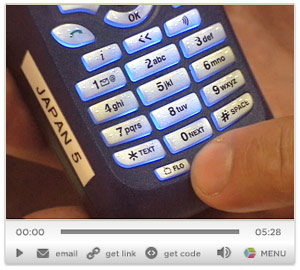 SoftBank announced that it has established a new company, Mobile Media Planning Corp., which aims to conduct technical research on MediaFLO and plan new services utilizing such technology. Developed by QUALCOMM, the system enables distribution of multichannel broadcast optimized for mobile communications, including Clipcast, and distribute digital terrestrial broadcasts to mobile terminals and other devices. This technology is considered as one of the three major technologies following satellite broadcast and 1Seg broadcast, and it enables real time broadcast of 20 channels on one TV channel portion of frequency band (6MHz). We interviewed MediaFlo’s Ali Zamari during the recent Wireless Japan trade-show in Tokyo.
SoftBank announced that it has established a new company, Mobile Media Planning Corp., which aims to conduct technical research on MediaFLO and plan new services utilizing such technology. Developed by QUALCOMM, the system enables distribution of multichannel broadcast optimized for mobile communications, including Clipcast, and distribute digital terrestrial broadcasts to mobile terminals and other devices. This technology is considered as one of the three major technologies following satellite broadcast and 1Seg broadcast, and it enables real time broadcast of 20 channels on one TV channel portion of frequency band (6MHz). We interviewed MediaFlo’s Ali Zamari during the recent Wireless Japan trade-show in Tokyo.
Mobile Media Planning plans to provide digital-tv broadcast distribution services for mobile terminals and other devices utilizing such technology for the development of mobile communications business of the SOFTBANK Group. Also, Mobile Media Planning will work on the study of technical potential of MediaFLO, by participating in the activities organized by external parties such as the VHF/UHF-band efficient use working group in Information and Communications Council, which discusses the proposal of multimedia broadcast technology including MediaFLO, and FLO Forum where supporting enterprises from around the world, such as QUALCOMM, participate.


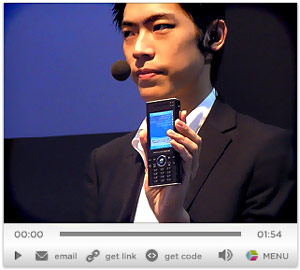 Currently in it’s 11th year,
Currently in it’s 11th year, 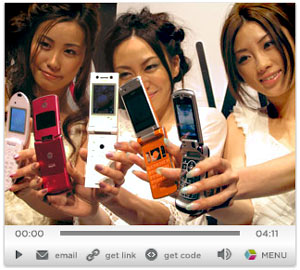 DoCoMo today announced six summer 3G handsets, including ‘7-Series’ models from US maker Motorola, Sharp, NEC, Panasonic and Mitsubishi. The Japan-made models include three ‘designer’ phones, with ultracool shapes and colours conceived by noted Japanese design personalities, while Motorola joins the show with their M702iS and M702iG — the latter evidently based on the newest version of the widely popular ‘RAZR’ series, the Razr V3X.
DoCoMo today announced six summer 3G handsets, including ‘7-Series’ models from US maker Motorola, Sharp, NEC, Panasonic and Mitsubishi. The Japan-made models include three ‘designer’ phones, with ultracool shapes and colours conceived by noted Japanese design personalities, while Motorola joins the show with their M702iS and M702iG — the latter evidently based on the newest version of the widely popular ‘RAZR’ series, the Razr V3X. DCMX: Is it a phone that can buy stuff or a credit card that can make calls? NTT DoCoMo is hoping that millions of spend-free consumers won’t know or care about the distinction and will simply use the new ‘DCMX’ credit-card phone for, well, pretty much everything. For small, daily purchases — like a six-pack and a take-out bento lunch — use the phone’s e-money FeliCa chip with no authentication required; for larger buys (a cool Louis Vuitton bag from the Omotesando boutique), use the DCMX credit-card function with a swipe and a PIN code; later, the phone will eyeball you for biometric authorization. “We wish to combine telecoms with financial services,” says DoCoMo’s Mr i-mode, Takeshi Natsuno, in today’s video program — and if there’s a cellco anywhere in the world that can afford the value-chain coordination costs to deploy a workable phone/credit card combo, it has to be NTT DoCoMo.DCMX is a logical progression from the carrier’s popular ‘o-saifu keitai’ IC-chip handsets that can store value onboard for small, daily purchases, and the launch announcement confirms DoCoMo’s strategic course aiming squarely at making the network-connected phone the payment method of choice for millions of Japanese. Maybe one day something this useful will be offered by carriers elsewhere?
DCMX: Is it a phone that can buy stuff or a credit card that can make calls? NTT DoCoMo is hoping that millions of spend-free consumers won’t know or care about the distinction and will simply use the new ‘DCMX’ credit-card phone for, well, pretty much everything. For small, daily purchases — like a six-pack and a take-out bento lunch — use the phone’s e-money FeliCa chip with no authentication required; for larger buys (a cool Louis Vuitton bag from the Omotesando boutique), use the DCMX credit-card function with a swipe and a PIN code; later, the phone will eyeball you for biometric authorization. “We wish to combine telecoms with financial services,” says DoCoMo’s Mr i-mode, Takeshi Natsuno, in today’s video program — and if there’s a cellco anywhere in the world that can afford the value-chain coordination costs to deploy a workable phone/credit card combo, it has to be NTT DoCoMo.DCMX is a logical progression from the carrier’s popular ‘o-saifu keitai’ IC-chip handsets that can store value onboard for small, daily purchases, and the launch announcement confirms DoCoMo’s strategic course aiming squarely at making the network-connected phone the payment method of choice for millions of Japanese. Maybe one day something this useful will be offered by carriers elsewhere?  A long-time friend of WWJ, Walter Adamson, founder and principal at Digital Investor, sat down with us to share his latest presentation, “Strategic Planning for Successful International Expansion: Lessons Learned from Asia’s Failed Experiences,” a primer on the mistakes that mobile content companies have made while trying to expand across borders, with a focus on Japan and Australia. In the Japanese case, some have succeeded, but many others have not and Walter has provided a clear outline of common mistakes.
A long-time friend of WWJ, Walter Adamson, founder and principal at Digital Investor, sat down with us to share his latest presentation, “Strategic Planning for Successful International Expansion: Lessons Learned from Asia’s Failed Experiences,” a primer on the mistakes that mobile content companies have made while trying to expand across borders, with a focus on Japan and Australia. In the Japanese case, some have succeeded, but many others have not and Walter has provided a clear outline of common mistakes.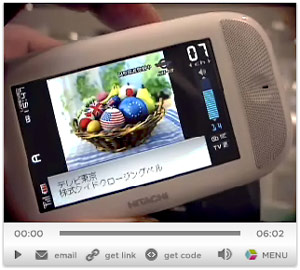 NHK and five commercial TV broadcasters held a splashy launch party in Tokyo’s central Shinjuku train station on Saturday afternoon, announcing the official start of terrestrial ‘One-Seg’ broadcast services. The carriers have lined up accordingly: NTT DoCoMo has partnered with Nippon Television and Fuji Television, while KDDI has forged a partnership with TV Asahi.
NHK and five commercial TV broadcasters held a splashy launch party in Tokyo’s central Shinjuku train station on Saturday afternoon, announcing the official start of terrestrial ‘One-Seg’ broadcast services. The carriers have lined up accordingly: NTT DoCoMo has partnered with Nippon Television and Fuji Television, while KDDI has forged a partnership with TV Asahi.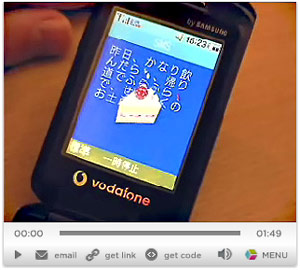 Here’s a quick video clip we shot at the Vodafone press conference when they introduced the new V804SS handset by Samsung — the first Samsung handset in Japan — going on sale here finally today. It has a few up-close examples of the company’s new dynamic email application, “Deru Moji” 3D Pictogram Display with pop-up animations, that we thought were pretty interesting.
Here’s a quick video clip we shot at the Vodafone press conference when they introduced the new V804SS handset by Samsung — the first Samsung handset in Japan — going on sale here finally today. It has a few up-close examples of the company’s new dynamic email application, “Deru Moji” 3D Pictogram Display with pop-up animations, that we thought were pretty interesting. For Vodafone Japan, the end came not with a bang, but with a whimper. When we arrived at last Monday’s press event – the final one, it turned out, before news of the Japan sell-out hit the Web – the smell of pending doom hung in the air. Ironically, the media briefing bore an optimistic title: the “Future Direction of Product & Service Development.” It was also surprising to see that President Bill Morrow and Chairman Tsuda-san would attend for the 3G roadmap briefing to be given by former J-Phone super-star Ohta-san; WWJ has never seen three Vodafone Big Guys in one room together for a media briefing (perhaps there is safety in numbers)? But when the talk from all three turned out vague and totally avoided any mention of new MVNO’s signing up to resell Vodafone 3G capacity — widely considered to be one of Big Red’s few viable options in Japan — we suspected something was up.
For Vodafone Japan, the end came not with a bang, but with a whimper. When we arrived at last Monday’s press event – the final one, it turned out, before news of the Japan sell-out hit the Web – the smell of pending doom hung in the air. Ironically, the media briefing bore an optimistic title: the “Future Direction of Product & Service Development.” It was also surprising to see that President Bill Morrow and Chairman Tsuda-san would attend for the 3G roadmap briefing to be given by former J-Phone super-star Ohta-san; WWJ has never seen three Vodafone Big Guys in one room together for a media briefing (perhaps there is safety in numbers)? But when the talk from all three turned out vague and totally avoided any mention of new MVNO’s signing up to resell Vodafone 3G capacity — widely considered to be one of Big Red’s few viable options in Japan — we suspected something was up. Tomi Ahonen is a smart guy who’s done a lot of observing and thinking about the 3G future. He reports that planet Earth has 2 bn mobile phones, with more phones in use than cars, credit cards or televisions, and that advertisers, businesses and governments are all trying to understand how the mobile future will download. For a glimpse into the future, Tomi was in Tokyo last month for the
Tomi Ahonen is a smart guy who’s done a lot of observing and thinking about the 3G future. He reports that planet Earth has 2 bn mobile phones, with more phones in use than cars, credit cards or televisions, and that advertisers, businesses and governments are all trying to understand how the mobile future will download. For a glimpse into the future, Tomi was in Tokyo last month for the  Here’s a fun web video for everyone to enjoy from all of us here at Wireless Watch Japan! We stopped by KDDI’s
Here’s a fun web video for everyone to enjoy from all of us here at Wireless Watch Japan! We stopped by KDDI’s